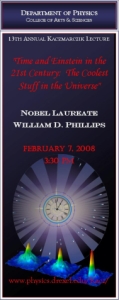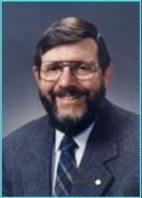13th Kaczmarczik Lecture
"Time and Einstein in the 21st Century: The Coolest Stuff in the Universe"
William D. Phillips
NIST and University of Maryland
1997 Nobel Laureate
Thursday, February 7, 2008
3:30 p.m.
Main Building Auditorium
3141 Chestnut Street
Philadelphia, PA 19104
 At the beginning of the 20th century, Einstein published three revolutionary ideas that changed forever how we view Nature. At the beginning of the 21st century Einstein's thinking is shaping one of the key scientific and technological wonders of contemporary life: atomic clocks, the best timekeepers ever made. Such super-accurate clocks are essential to industry, commerce, and science; they are the heart of the Global Positioning System (GPS), which guides cars, airplanes, and hikers to their destinations. Today, atomic clocks are still being improved, using Einstein's ideas to cool the atoms to incredibly low temperatures. Atomic gases reach temperatures less than a billionth of a degree above Absolute Zero, without solidifying. Such atoms enable clocks to be accurate to better than a second in 60 million years, while both using and testing some of Einstein's strangest predictions.
At the beginning of the 20th century, Einstein published three revolutionary ideas that changed forever how we view Nature. At the beginning of the 21st century Einstein's thinking is shaping one of the key scientific and technological wonders of contemporary life: atomic clocks, the best timekeepers ever made. Such super-accurate clocks are essential to industry, commerce, and science; they are the heart of the Global Positioning System (GPS), which guides cars, airplanes, and hikers to their destinations. Today, atomic clocks are still being improved, using Einstein's ideas to cool the atoms to incredibly low temperatures. Atomic gases reach temperatures less than a billionth of a degree above Absolute Zero, without solidifying. Such atoms enable clocks to be accurate to better than a second in 60 million years, while both using and testing some of Einstein's strangest predictions.
 William D. Phillips was born in 1948, in Wilkes-Barre PA, and attended public schools in Pennsylvania. He received the B.S. in Physics from Juniata College in 1970 and the Ph.D. from MIT in 1976. After two years as a Chaim Weizmann postdoctoral fellow at MIT, he joined the staff of the National Institute of Standards and Technology in 1978. He is a NIST Fellow, leader of the Laser Cooling and Trapping Group in the Atomic Physics Division of NIST's Physics Laboratory, and is a professor of physics at the University of Maryland, College Park. Dr. Phillips is a fellow of the American Physical Society, the Optical Society of America, the American Academy of Arts and Sciences, and a member of the National Academy of Sciences. He is the recipient of the Gold Medal of the U.S. Department of Commerce (1993), the Michelson Medal of the Franklin Institute (1996) and the Schawlow Prize of the American Physical Society (1998). In 1997, Dr. Phillips shared the Nobel Prize in Physics with Dr. S. Chu of Stanford University, and Dr. C. Cohen-Tannoudji, of the Collège de France and École Normale Supérieure "for development of methods to cool and trap atoms with laser light."
William D. Phillips was born in 1948, in Wilkes-Barre PA, and attended public schools in Pennsylvania. He received the B.S. in Physics from Juniata College in 1970 and the Ph.D. from MIT in 1976. After two years as a Chaim Weizmann postdoctoral fellow at MIT, he joined the staff of the National Institute of Standards and Technology in 1978. He is a NIST Fellow, leader of the Laser Cooling and Trapping Group in the Atomic Physics Division of NIST's Physics Laboratory, and is a professor of physics at the University of Maryland, College Park. Dr. Phillips is a fellow of the American Physical Society, the Optical Society of America, the American Academy of Arts and Sciences, and a member of the National Academy of Sciences. He is the recipient of the Gold Medal of the U.S. Department of Commerce (1993), the Michelson Medal of the Franklin Institute (1996) and the Schawlow Prize of the American Physical Society (1998). In 1997, Dr. Phillips shared the Nobel Prize in Physics with Dr. S. Chu of Stanford University, and Dr. C. Cohen-Tannoudji, of the Collège de France and École Normale Supérieure "for development of methods to cool and trap atoms with laser light."
High School Open House Program:
12:30 - 1:00 p.m. Main Building Auditorium
1:00 - 3:00 p.m. Department of Physics Open House
Brief presentations on Biophysics, Astrophysics, Computational Physics, Condensed Matter, Nonlinear Dynamics, Particle Physics, etc. An excellent opportunity for high school students to visit our laboratories and meet in person with our internationally recognized researchers.
3:00 - 3:30 p.m.Reception
About the Kaczmarczik Lecture
Paul Kaczmarczik began his career as a Professor of Physics at Drexel University in 1953. A key player in building the Physics and Atmospheric Science Department, he made important contributions to teaching at Drexel University during his many years of service. Well-liked by both his colleagues and his students, Professor Kaczmarczik became Professor Emeritus in 1989. The Kaczmarczik Lecture Series was established in 1995 in honor of Professor Kaczmarczik. It brings to Drexel outstanding scientists to present lectures on topics at the cutting edge of Physics research.